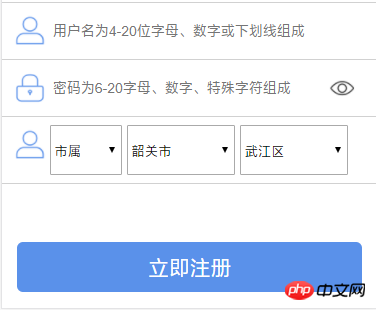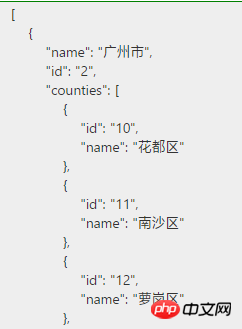本文主要介紹了Angular4自製一個市縣二級連動組件範例,小編覺得挺不錯的,現在分享給大家,也給大家做個參考。一起跟著小編過來看看吧,希望能幫助大家。
最近遇到了不少問題,真的是命運多舛。 Angular真是讓人又愛又恨的框架,恨的是資料太少,遇到問題無從下手。愛的是許多其他框架難以做到的功能,angular可以輕鬆做到。
話不多說,最近遇到了一個舊專案改造的問題。拿到前同事做的頁面效果:

第一眼就看到了這三個下拉框,按捺不住好奇心的我點了點。原來,第一個下拉框可以選擇市屬和省級,如果選擇市屬,那麼後面就會出現市、縣級兩個下拉框,如果是省級,那就隱藏了,這個挺容易的。然後就是要選擇城市之後,區下拉框要有對應區縣選項。 emmmm,很典型的二級連動,不過既然分析完了思路,那就開始做吧!首先呢,資料一定要從後端同事那裡拿,呼叫他的介面把資料填進去。看看資料是什麼樣子的:

資料略多,就不全部貼出來了。把實體bean創建一下,
// 市级实体类
export class City {
// 市级id
cityId: string;
// 所属类型(0.市属 1.省属)
cityType: number;
// 市级名称(可选属性,若cityType为1时,可不填)
cityName: string;
// 所属区县
counties?: Array<Country>;
}
// 区县级实体类
export class Country {
// 区县id
countryId: string;
// 区县名称
countryName: string;
}
// 填写市县类
export class CityAndCountry {
// 市级id
cityId: string;
// 县级id
countryId: string;
// 市级类型
cityType: number;
// 市县级实体构造器
constructor() {
// 给市级id赋予一个真实城市的id初始值
this.cityId = '***';
// 同上
this.countryId = '***';
// 同上
this.cityType = 0;
}
}實體完成了,開始準備取得資料並填入實體:
##
// 二级联动组件
export class CityAreaComponent implements OnInit, OnDestroy {
// 结果码 (用于页面处理显示标识)
result_code: number;
// 市级实体声明
city: City[];
// 县区级实体声明
country: Country[];
// 市县、区级填写实体声明
cac: CityAndCountry;
// 声明订阅对象
subscript: Subscription;
/**
* 构造器
* @param {CityService} service 注入服务
*/
constructor (private service: CityService) {
// 结果码 (-1.网络或其他异常 0.无内容 1.请求成功 2.请等待)
this.result_code = 2;
// 初始化填写市区、县级填写实体
cac = new CityAndCountry();
// 初始化数组(这步很重要,有很多人说使用数组相关函数会报未定义异常,是因为没有初始化的原因)
this.city = [];
this.country = [];
// 初始化订阅对象
this.subscript = new Subscription();
}
/**
* 生命周期初始化钩子(生命周期尽量按执行顺序来写,养成好习惯)
*/
ngOnInit(): void {
this.getCityArea();
}
/** 获取市县数据 */
getCityArea() {
/** 将请求交付服务处理(service代码比较简单,就不贴了) */
this.subscript = this.service.getCityArea().subscribe(res => {
/** 获取json请求结果 */
const result = res.json();
/** 判断结果返回码 */
switch (result['code']) {
/** 请求成功,并且有值 */
case 200:
/** 改变初始返回码 */
this.result_code = 1;
/** 获取并填充数据 */
this.city = json['city'];
break;
/** 其他情况不重复赘述 */
}
}, err => {
/** 显示预设异常信息提示给用户 */
this.result_code = -1;
/** 打印log,尽量使用日志产出 */
console.error(err);
});
}
/** 生命周期销毁钩子 */
ngOnDestroy(): void {
/** 取消订阅 */
this.subscript.unsubscribe();
}
}<!-- 所属类型(此处固定,一般为获取后端数据字典数据) -->
<select class="city_type" [value]="cac.cityType" [(ngModel)]="cac.cityType">
<!-- 所传内容为整数型 -->
<option value=0>市属</option>
<option value=1>省属</option>
</select>
<!-- 市级选择(类型为省属时隐藏) -->
<select class="city" [value]="cac.cityId" [(ngModel)]="cac.cityId" *ngIf="city.cityType==0">
<!-- 遍历城市数组 -->
<option *ngFor="let opt of option" [value]="opt.cityId">{{opt.cityName}}</option>
</select>// 二级联动组件
export class CityAreaComponent implements OnInit, OnDestroy, DoCheck{
// 声明县区级数组
country: Array<Country>;
constructor() {
/** 重复代码不赘述 */
/** 初始化数组 */
country = [];
}
/** 生命周期检测变化钩子 */
ngDoCheck(): void {
/** 遍历市级数组 */
for (let i = 0; i < this.city.length; i++) {
/** 若选择的市级id和市级数组中的id相吻合 */
if (this.city[i].id == this.cac.countryId) {
/** 将该索引下的counties数组赋予给区县级数组 */
this.country = this.city[i].counties;
}
/** 我们无法避免直辖市的情况,所以多一重判断 */
if (this.country.length > 0) {
/** 为了用户体验,我们要尽量在用户选择市级城市后,默认选择一个区县级城市 */
this.cac.country.id = this.country[0].id;
}
}
}
}
#
<!-- 区县级下拉框 -->
<select [value]="cac.countryId" [(ngModel)]="cac.countryId" *ngIf="cac.cityType==0 && country.length > 0">
<option *ngFor="let count of country" [value]="count.id">{{count.name}}</option>
</select>以上是Angular4自製一個市縣二級連動組件詳解的詳細內容。更多資訊請關注PHP中文網其他相關文章!




